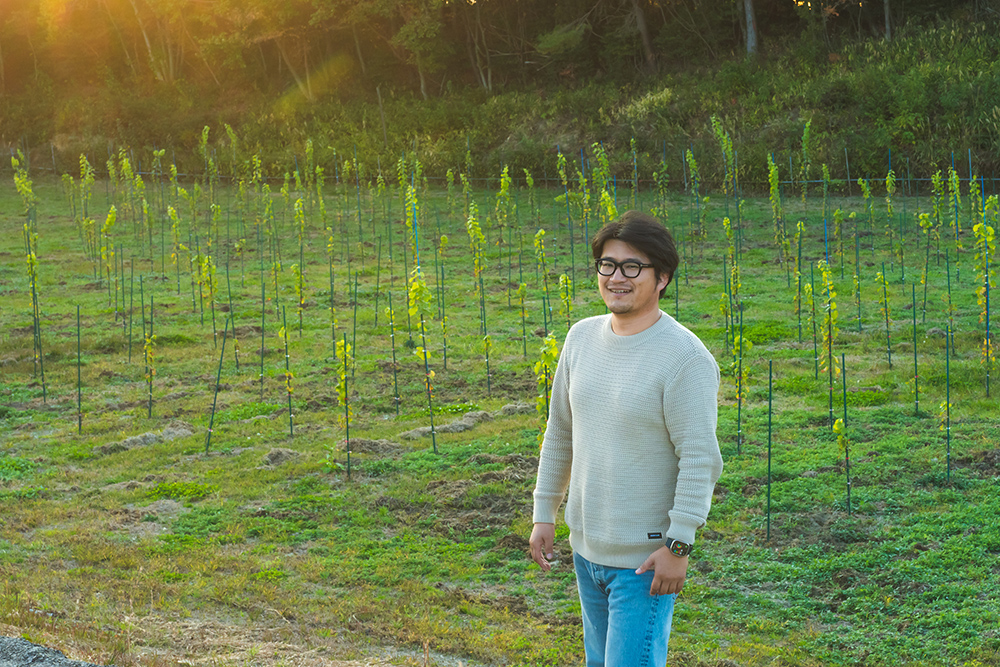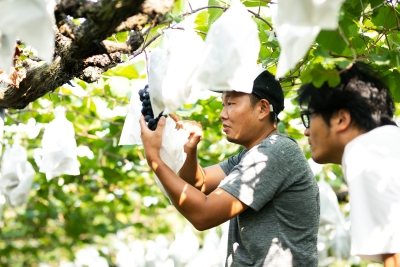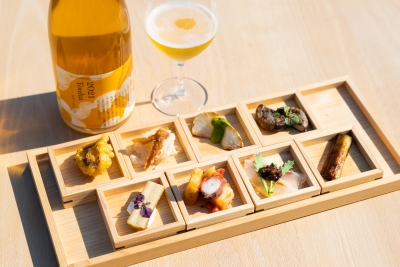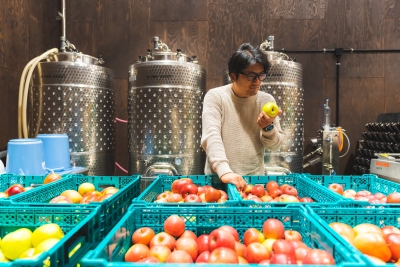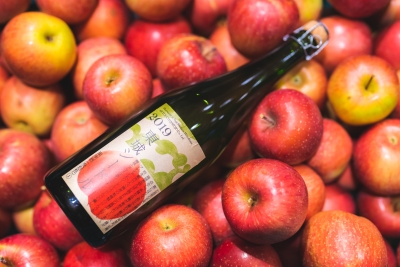Creating New Value—the Setouchi Terroir
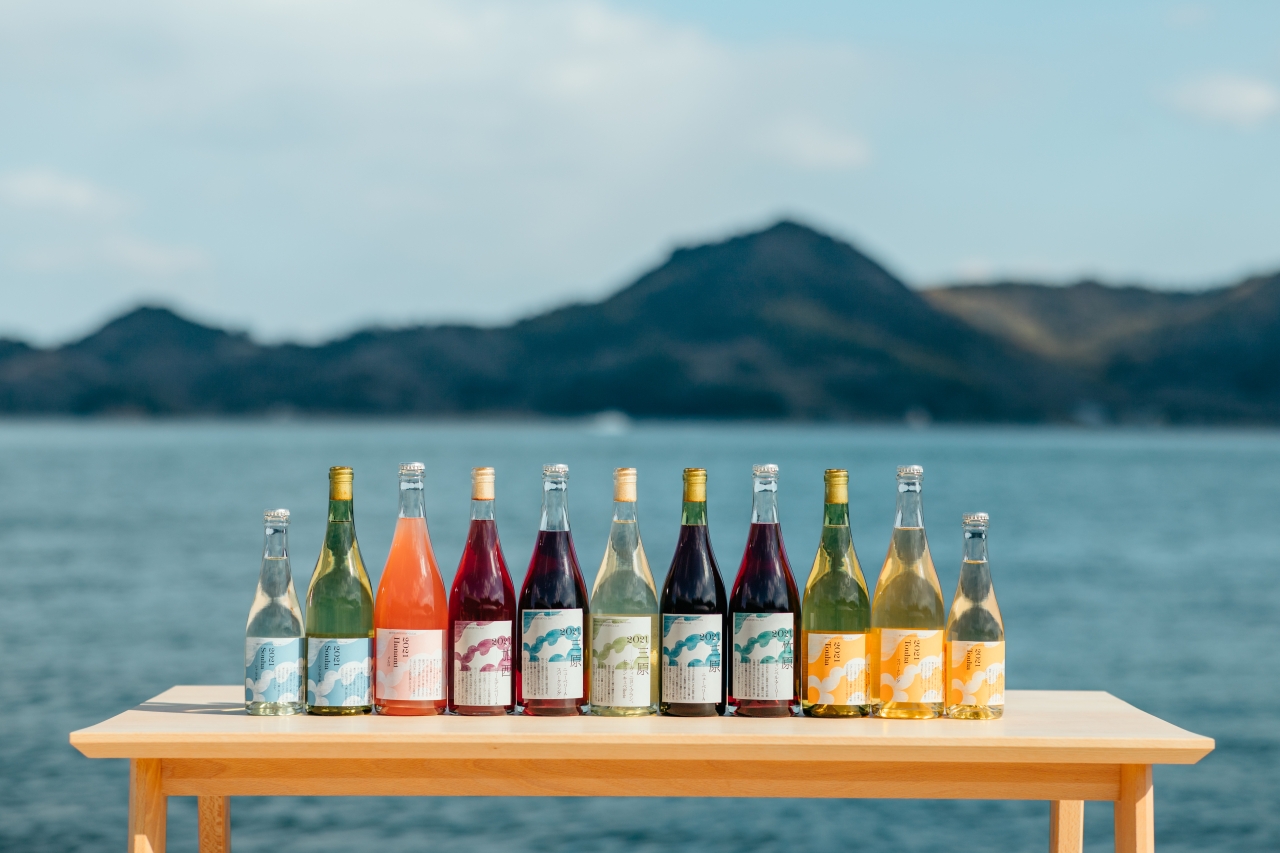
SETOUCHIJOZOJO, the closest winery to the sea in Japan, was established in 2021 on the remains of a shipyard in Sunami, an area in Mihara City in Hiroshima Prefecture. Right in front of the winery is Mihara-Seto, where is said to be one of the most popular sights of the Seto Inland Sea for the beautiful landscape of many islands. The winery’s buildings cut the landscape which is picturesque and spreads over wherever you see. The concept for SETOUCHIJOZOJO is “Wine and Winery that Travels around Setouchi.” Utilizing the unique features of each ingredients’ producing regions, they produce wine and cider without any additional sugar, placing the utmost value on the original flavor of the fruits and the producers’ thoughts and ideas. At the winery’s adjoining restaurant, Mio, visitors can enjoy pairing seasonal foods from the Setouchi area and various wines and ciders created from products from the mountains. The restaurant has recently garnering attention as a new tourist hotspot of the Seto Inland Sea. For Yuya Ota, owner of the winery and restaurant, this was not a family business, nor does he have any experience in winery and restaurant management. Ota says that the biggest power in setting up the business from the ground up was “co-creation with regional stakeholders.”
Inheriting the Local Primary Industry and Food Culture to the Next Generation
Although not widely known, Hiroshima Prefecture is in fact one of the leading producers of table grapes in Japan. In recent years, however, aging farming population has made it difficult to pass on farming techniques. This has led to a noticeable increase in fallow land and a decrease in production volumes.
Ota is originally from Mihara City. Moved to Tokyo to go to university, he studied law at graduate school and then worked for a consulting firm. At the age of 26 he set up “for C, Inc.”, offering consulting services for regional development. Ota says, “Despite of working to support the establishment of DMOs and to create tourism brands, aging farming population and a lack of successors meant that the techniques were not being passed on, and in turn abandoned farmland was increasing. I knew I had to do something as thiswas essentially meaningless.”
With this in mind, while cycling along the Shimanami Kaido in May 2017 and taking in the sights of the Seto Inland Sea’s beautiful islands, Ota came up with the idea that how great it would be if there was alcoholic beverage for each of the island.
The processes in wine production are relatively simple, and wines are also said to be well-suited to express the unique characteristics of the land where they are produced. Even wines of the same type tastes different depending on the producing region, making it ideal for conveying the history and story of a region. I hope to create synergy to the region’s agriculture and food by producing wine that expresses the terroir of Setouchi, and communicating the charms of local regions to people Japan and abroad through wine. This strong desire stirred Ota into action.
Takasakacho in Mihara City— the Starting Point for Co-creation
Takasakacho in Mihara City is the production area of New Bailey A grapes, also known as Buttsuji-budo. Ota’s project began by visiting grape farmers in the area and asking them to share some grapes for wine.
“’What is this guy thinking?’ and “Is it even possible to make wine?” This is probably how the farmers felt when I visited and suddenly asked them for some grapes to make some wine.
However, after producing the first bottle of wine, there were signs of change,” says Ota.
He continues, “The fact that we produced wine from local grapes attracted media, and as a result sales of New Bailey A, which previously had been outshone by Shine Muscat, grew significantly. Grape farmers then began to see further potential in their own grapes, and fortunately, they felt more attractive to work with me.”
Ota outsourced his wine production, and began selling it in 2018. It was in March 2021 that construction of his own winery and restaurant was finished. Today, with Takasaka Town, Mihara City as the starting poing, Ota is working with Takehara City and other producing regions in Setouchi to produce Mihara New Bailey A, Takano Cider, and other wine and cider that represent each region.
“As soon as I saw the location, I knew it had to be here,” says Ota. That said, it took two difficult years for him to acquire the land, and there were various other hurdles to overcome before his facilities were completed, including subsidy applications and negotiations with financial institutions. “It is important to make a first step with a strong desire to realize, and to create a form first. It’s really challenging to gain people’s trust without anything. It’s only because I brought the potential and value of the region into the form of SETOUCHIJOZOJO that now I am expected and supported by local farmers, saying, “”You need to make success.”” Today I am realizing the benefits of ‘regional co-creation’,” says Ota.
The architect behind the winery and restaurant was Daisuke Sugawara. With ‘storytelling landscape’ as the concept, the idea was that the building was designed to frame the surrounding features, including the sea and mountains of the Setouchi area, as well as the structure of the former shipyard. The design incorporates various elements that accentuate the beauty of the building.
The restaurant’s menu is overseen by Zempei Fujita, a native of Setouchi and owner chef of Atelier Fujita in Yoyogi-Uehara in Tokyo. Responsible for setting up the winery was Masaki Takasaku, who studied at the prestigious Domaine Simon Bize in Burgundy, France. The restaurant’s furniture and cutlery, meanwhile, are courtesy of SAKURASAKU, a furniture and architecture workshop in Mihara City. This co-creation with local professionals in every little detail also gives SETOUCHIJOZOJO great strength.
Sustainable Initiatives to Solve Regional Challenges
One of SETOUCHIJOZOJO’s aims is to bring sustainability to local agriculture through dialog with the community.
Shobara City, where temperatures vary greatly depending on the seasons, has been a famous apple-producing region since the Taisho era. In 2021, Ota was contacted by an apple farmer from Shobara that this year’s harvest would be significantly lower than usual due to frost forming on the flower buds. Ota immediately travelled to the orchard. Upon arriving, he noticed a tree with more small apples than usual. According to the farmer, the tree was to be used for pollination.
“The farmer told me that the apples were too sour to eat, but I thought they would be ideal for producing alcohol. I thus purchased them at the regular price and produced a batch of cider. It was delicious,” Ota says.
Ota has made it a policy to purchase ingredients at regular prices even if they are irregular in shape and size, as well as slightly out of season. He also purchased all of the grapes that were produced from seedlings that he provided to farmers. In these and other ways, he has helped both ensuring a stable income for farmers and solving the problem of shortage of successors. Elsewhere, Ota uses abandoned farmland to cultivate grapes of his own, and is on the same path and in the same position as local producers. At the restaurant, Ota uses local ingredients, as well as off-spec produce that are not priced inthe market, to showcase the local terroir and reduce food miles. Further, to reduce food waste as much as possible, the restaurant operates on a reservation basis.
The winery and restaurant opened in the midst of the pandemic, and so the development of overseas markets and attract inbound tourists is still to come. However, Ota’s products have already won high acclaim from overseas buyers, and he plans to implement a cross-border e-commerce system to first target Asian consumers such as in China and Thailand. Ota is aiming high, “My goal is to make Japanese wine a category of its own. I want to continue communicating the charms of the Setouchi terroir, which we have co-created with the local people, to the rest of the world.” The regional co-creation story continues.

